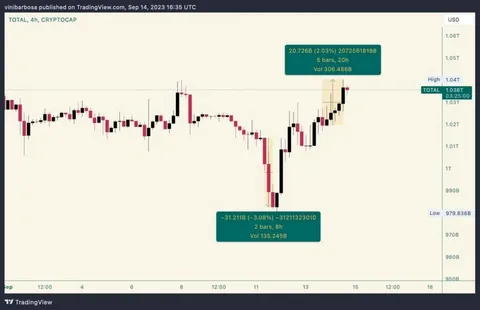Introduction
The past few years have seen Bitcoin fluctuate in value more dramatically than any other mainstream financial asset, partly due to its decentralized nature and the speculative sentiment surrounding it. However, when Bitcoin experiences a $1 billion surge in value in just 24 hours, questions arise about what catalyzed such a sharp increase.
Market movements like this are often the result of a complex combination of factors ranging from institutional investment to regulatory news, macroeconomic indicators, and technological advancements. This post explores these components to provide a clearer understanding of how they contributed to it’s meteoric rise.
Understanding Bitcoin’s market dynamics requires a broad look at multiple dimensions that impact its price. These include investor sentiment, economic influences, and emerging developments in the world of cryptocurrency. We will explore each of these aspects to explain how it managed to achieve such a significant market movement in such a short time.

1. Institutional Investment: The Driving Force Behind Bitcoin’s Market Movement
One of the primary factors behind Bitcoin’s $1 billion surge within 24 hours is the increasing interest from institutional investors. In recent years, it has graduated from a niche asset class with mostly retail investors to a financial instrument that has attracted the attention of some of the world’s largest financial institutions.
This trend of institutional investment began gaining momentum after the first major Bitcoin bull run in 2017, which saw the price of Bitcoin reach nearly $20,000. Fast forward to 2020 and beyond, and companies such as MicroStrategy, Tesla, and Square made headlines with their substantial Bitcoin purchases.
Institutional players view it as a hedge against inflation and a store of value similar to gold. When institutional investors buy large quantities of Bitcoin, it creates significant upward pressure on the price, leading to market movements such as the $1 billion surge.
Additionally, institutional-grade investment products like Bitcoin futures and ETFs have made it easier for large entities to gain exposure to the cryptocurrency without actually holding it. This influx of institutional capital, combined with the increased legitimacy that these products bring to the market, helped push it’s value to new heights during the surge.
The growing involvement of institutions signals a broader adoption of Bitcoin, lending it greater stability and legitimacy in the eyes of the financial world. Their confidence in Bitcoin’s potential to serve as a viable investment option has been a significant catalyst in driving market movements, such as the recent $1 billion increase.
2. Macroeconomic Factors: Global Trends Fueling Bitcoin’s Rise
Bitcoin does not exist in a vacuum. Its price is highly sensitive to global macroeconomic trends, particularly inflation concerns, central bank policies, and currency depreciation. Over the past few years, these factors have contributed to Bitcoin’s appeal as a hedge against traditional financial systems, which many see as faltering due to excessive money printing and rising national debts.
The COVID-19 pandemic and the subsequent economic policies adopted by governments worldwide played a major role in fueling the demand for Bitcoin. As central banks printed trillions of dollars to stimulate economies, many investors began looking for alternatives to fiat currencies. This flight to alternative assets, particularly it, has become a defining feature of the post-pandemic financial landscape.
When inflation fears rise, assets like Bitcoin are often viewed as safe havens. Bitcoin’s fixed supply of 21 million coins makes it an attractive store of value compared to inflation-prone fiat currencies. During periods of inflation or currency devaluation, investors often flock to Bitcoin, contributing to its price spikes and market movement, such as the $1 billion surge we are analyzing.
Another significant macroeconomic factor is the global trend towards de-dollarization. As nations like China and Russia seek alternatives to the U.S. dollar for international trade, Bitcoin is increasingly being considered as a potential global reserve currency. While it’s unlikely to replace the dollar anytime soon, this shift in sentiment has nonetheless added to it’s bullish momentum.
These macroeconomic dynamics have a profound influence on Bitcoin’s price, making it an essential factor in understanding the $1 billion surge in 24 hours. it’s role as a digital asset immune to inflationary pressures and currency manipulations has cemented its status as a sought-after investment during times of economic uncertainty.
3. Market Sentiment and Social Media Influence
Sentiment within the cryptocurrency community and the broader investment ecosystem plays a critical role in driving it’s price. When Bitcoin experiences a surge of $1 billion in a short period, market sentiment often becomes overwhelmingly bullish, which can further propel its upward movement.
Market sentiment is frequently shaped by social media platforms such as Twitter, Reddit, and even TikTok, where influencers and crypto enthusiasts discuss the latest developments in the market. Positive sentiment often follows significant news events, such as major institutional purchases or regulatory approvals. When such news spreads rapidly across social media, it creates a “fear of missing out” (FOMO) among retail investors, who then rush to buy Bitcoin, further driving up its price.
In the case of the recent surge, platforms like Reddit’s r/Cryptocurrency and Twitter’s crypto community buzzed with speculation about Bitcoin’s future price trajectory. The strong momentum on social media often correlates with increased trading volumes on major exchanges, pushing it’s price upward.
Another factor contributing to positive market sentiment is the concept of “whale” activity. These whales are individuals or entities that hold large quantities of it. When they start buying or moving large amounts of Bitcoin, the market often follows. Whale activity can create significant upward pressure, contributing to the kind of $1 billion market movement we witnessed in a single day.
Sentiment is a crucial driver of it’s market behavior. While institutional and macroeconomic factors lay the groundwork, it’s often the buzz and excitement generated on social media that propel Bitcoin’s price during surges like the one we saw.
4. Technological Developments and Network Upgrades
Bitcoin’s underlying technology also plays a pivotal role in its price movements. Technological advancements, upgrades to the Bitcoin network, and developments in adjacent areas such as blockchain and decentralized finance (DeFi) all contribute to it’s overall market performance.
One of the most important recent developments has been the implementation of the Taproot upgrade, which improved it’s scalability, privacy, and smart contract functionality. Taproot represents a significant evolution for Bitcoin, positioning it as more than just a store of value, but as a platform that can support more complex financial transactions.
Technological upgrades like Taproot increase investor confidence in the long-term viability of it. When the network becomes more efficient and secure, it attracts both new investors and existing holders looking to increase their positions. These technical improvements can lead to market surges, such as the $1 billion rise we observed within a 24-hour period.
Furthermore, the rise of Layer 2 solutions like the Lightning Network, which enables faster and cheaper it transactions, has contributed to the cryptocurrency’s growing utility. The promise of more efficient transactions makes it more attractive to everyday users, which can have a positive impact on its market price.
Technological innovations, combined with a strong narrative around it’s potential future use cases, provide a fertile ground for significant market movements. As it continues to evolve and improve, its value proposition becomes even more appealing, contributing to price surges like the $1 billion increase in a single day.
Conclusion
Bitcoin’s $1 billion surge within 24 hours was no accident. It was the result of a combination of institutional investments, macroeconomic factors, market sentiment, and technological advancements. Each of these elements plays a crucial role in shaping it’s market dynamics and contributing to its incredible price fluctuations.
As Bitcoin continues to evolve, both in terms of technology and adoption, it’s likely that we’ll see more of these significant surges in the future. Understanding the key factors behind such market movements can help both seasoned investors and newcomers make informed decisions about their positions in the crypto market.
Have you been tracking Bitcoin’s latest market movement? What are your thoughts on the $1 billion surge? Leave a comment below to share your insights and join the discussion!






